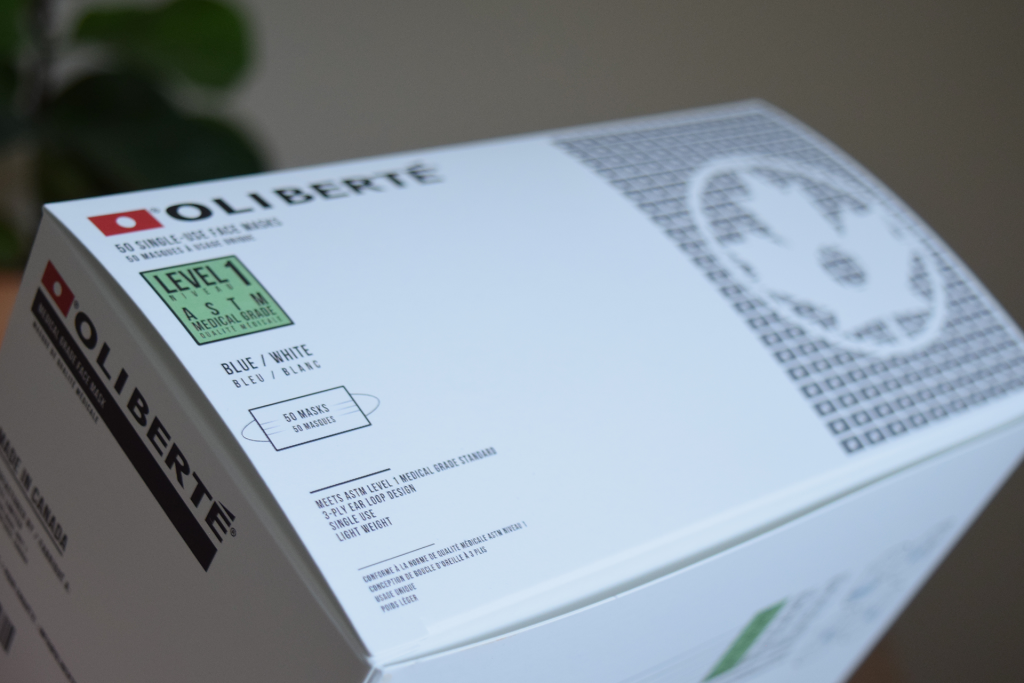
Dear Friends,
Quick Update
1. This week we crossed the 2 million mask mark made right here in Oakville, Ontario, Canada!
2. Today our second mask machine arrives. Over the next 10 days we will be installing the machinery, upgrading the electrical, adjusting the air supply and taking all the lessons learned from our first machinery installation and applying it to this machine.
3. I am also really excited to announce that we have ordered all the mechanical parts required to make Children masks here in Canada starting in early November.
So… you make Medical Masks, what does that even mean?
You have heard it called many things – face masks, disposable masks, surgical mask, medical mask, but they are not the same.
In short, the true answer is you can only call something a medical mask if the face mask or the material used to cover the face meets certain standards assigned by the organization, ASTM (https://www.astm.org/). This organization is whom North America’s government and public health authorities have agreed has the knowledge and research to decide what factors can classify any masks as medical or non-medical.
More specifically ASTM provides the parameters of what the standards are for different “levels” of medical masks. There is ASTM Level 1, 2 and 3.
(I am going to get a bit technical here.)
The key difference in the levels of masks is how much BFE (bacteria) and PFE (particulate – aka dust) the masks can protect against.
Level 1 masks can stop 95% of the PFE and BFE (the bad guys) and Level 2 can stop at least 98% of the bad guys. Depending on what and where you need the mask (if you are out and about or visiting a friend in the hospital or performing surgery), you will want different levels of protection.
The different levels also look at other factors such as if the masks can burn easily or not (flame test), how much liquid they can stop (blood penetration) and probably the one that you really notice is the breathability. The higher the level of masks, the standards allows for less breathability. It is still a safe amount, but you can expect the higher level masks are harder to breathe through since they are also using stronger materials to stop more bacteria and dust.
So, okay – if they meet the standards, medical masks are medical masks?
It is true that medical masks that test against the standard and pass are considered medical masks. BUT these tests can be skewed.
What do I mean? The ASTM face mask is not a hard standard – it is a guideline. So, it provides suggestion for certain things. For example, to test the PFE (dust) it allows you to use a large range of what is called face velocity.
For example, imagine your standing outside and you have a little fan (the size of your hand). You can feel gently on your face. Now you stand in front of a jet engine – when it turns on your entire body is lifted off the ground and moved.
So now imagine a mask. You are testing the same masks within the same standard that allows for you use a hand fan OR a jet engine. If you use the hand fan, your mask will not move and the dust stays in and you pass. You use the jet engine and your mask is smashed to pieces and you fail.
So, if you want to “pass” the test which fan do you think you would want to use if you are not 100% sure about your mask?
My point is here, we cannot all be scientist and if you are okay with just a pass to get something that says medical that is no problem. But here at Oliberte, we are working within the ASTM standard to make sure we are providing you the best medical masks that meets the higher standards of the ASTM parameters.
And so, I also challenge you when buying a mask from Oliberte or anyone – do not be afraid to ask for the test results of any medical masks you buy. We will soon be posting ours online so that we can continue to be transparent with you too. It is your right to know the details of what you buy and we will continue to provide that.
One last point. Are your medical materials Made in Canada?
While we may have been one of the first to make our masks in Canada, we are not the only ones. There are so many right now. We know that. But what I believe that continues to set us apart is how we operate and our focus on Made in Canada.
How? For me, it is not just enough to make it Canada, but where possible we source our raw materials from Canada as well. We are still working on some of our materials but we our targeting early 2021 to have a fully 100% made in Canada mask. See below our Canadian Content.
So that is it for this update. Thank you for continued support.
Crush Covid,
Tal





